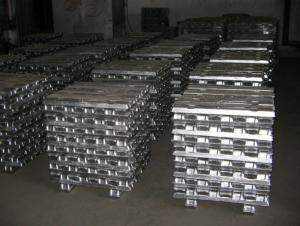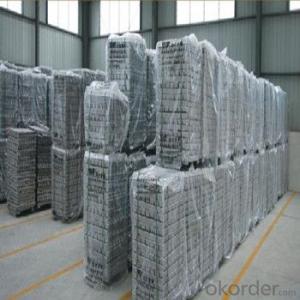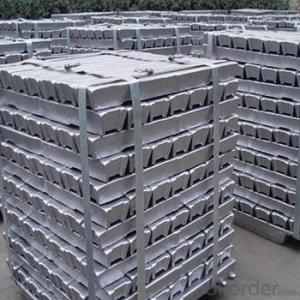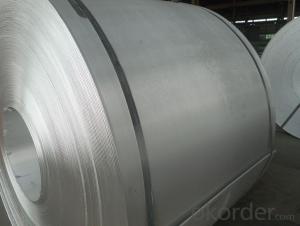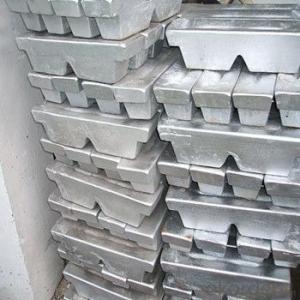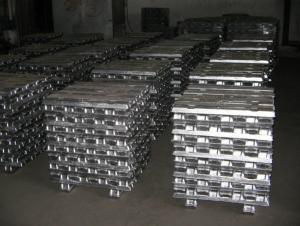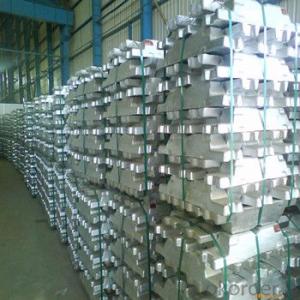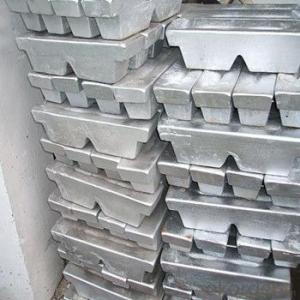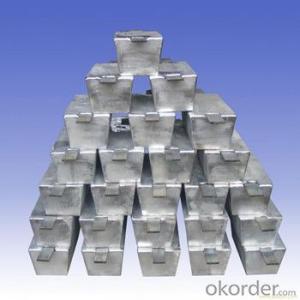Aluminum Pig/Ingot With Pime Grade With Competitive Price
- Loading Port:
- China main port
- Payment Terms:
- TT OR LC
- Min Order Qty:
- 1000 m.t.
- Supply Capability:
- 100000 m.t./month
OKorder Service Pledge
OKorder Financial Service
You Might Also Like
Pure Aluminum Pig/Ingot Used for Industry
1.Structure of Aluminum Pig/Ingot
A material that has been cast into a shape in order to be transported and processed easier than in an unprocessed form. An ingot is typically rectangular in shape, which allows it to be stacked. Ingots are most commonly associated with metals, with ingots of gold held in the vaults of banks and brokerages being popular images.
Aluminum Ingot is with the AL as the main chemical composition.Aluminum Ingot is used for industry,such as automobile,pinning and weaving,electron broadly and so on. Aluminum Ingot has the following advantages: easy control and operation, fast melting.
2.Main Features of the Aluminum Pig/Ingot
•High Purity
•Easy control and operation
•High strength
•Fast melting
•Competitive price
•Best Service
3.Aluminum Pig/Ingot Images

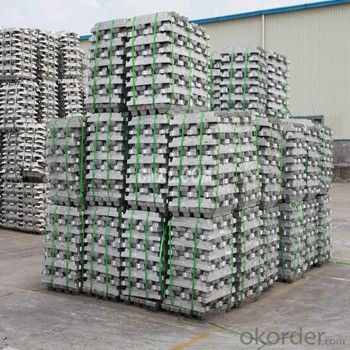
4.Aluminum Pig/Ingot Specification
Grade | Chemical Composition % | |||||||||
Al≥ | impurities ≤ | |||||||||
Si | Fe | Cu | Ga | Mg | Zn | Mn | others | Sum | ||
Al99.9 | 99.90 | 0.50 | 0.07 | 0.005 | 0.02 | 0.01 | 0.025 | - | 0.010 | 0.10 |
Al99.85 | 99.85 | 0.80 | 0.12 | 0.005 | 0.03 | 0.02 | 0.030 | - | 0.015 | 0.15 |
Al99.7 | 99.70 | 0.10 | 0.20 | 0.010 | 0.03 | 0.02 | 0.030 | - | 0.030 | 0.30 |
Al99.6 | 99.60 | 0.16 | 0.25 | 0.010 | 0.03 | 0.03 | 0.030 | - | 0.030 | 0.40 |
Al99.5 | 99.50 | 0.22 | 0.30 | 0.020 | 0.03 | 0.05 | 0.050 | - | 0.030 | 0.50 |
Al99.00 | 99.00 | 0.42 | 0.50 | 0.020 | 0.03 | 0.05 | 0.050 | - | 0.050 | 1.00 |
5.FAQ of Aluminum Pig/Ingot
We have organized several common questions for our clients,may help you sincerely:
①How about your company?
A big and famous and professional manufacturer & supplier of Aluminum Pig/Ingot, is one of the one of the large-scale professional investment Aluminum Pig/Ingot production bases in China.It have focuses on producing the Aluminum Pig/Ingot production for many years and gotten rich experience.Annually lagrge amount of Aluminum Pig/Ingot production are exported to markets in Europe,America and Japan. The quality and service have also gotten OEM service is available according to customer’s requirements.
②How to guarantee the quality of the products?
We have established the international advanced quality management system,every link from raw material to final product we have strict quality test;We resolutely put an end to unqualified products flowing into the market. At the same time, we will provide necessary follow-up service assurance.
③How long can we receive the product after purchase?
In the purchase of product within three wo We have organized several common questions for our clients,may help you sincerely:
①How about your company?
A big and famous and professional manufacturer & supplier of Aluminum Pig/Ingot, is one of the one of the large-scale professional investment Aluminum Pig/Ingot production bases in China.It have focuses on producing the Aluminum Pig/Ingot production for many years and gotten rich experience.Annually lagrge amount of Aluminum Pig/Ingot production are exported to markets in Europe,America and Japan. The quality and service have also gotten OEM service is available according to customer’s requirements.
②How to guarantee the quality of the products?
We have established the international advanced quality management system,every link from raw material to final product we have strict quality test;We resolutely put an end to unqualified products flowing into the market. At the same time, we will provide necessary follow-up service assurance.
③How long can we receive the prod rking days, We will arrange the factory delivery as soon as possible. The pecific time of receiving is related to the state and position of customers.Commonly 7 to 10 working days can be served.
- Q:What is the price of aluminum ingots in the market?
- Several factors, including supply and demand dynamics, global economic conditions, and market trends, can cause the price of aluminum ingots in the market to fluctuate. Based on my understanding, the typical price range for aluminum ingots is commonly between $1,800 and $2,200 per metric ton. Nevertheless, it is crucial to acknowledge that these prices are subject to modifications and may differ in various regions or at different periods. To obtain the most precise and current information, it is recommended to seek guidance from dependable sources such as metal industry reports, commodity exchanges, or aluminum sector market analysts.
- Q:How are aluminum ingots used in the production of appliances?
- Aluminum ingots play a significant role in the production of appliances due to their inherent properties and characteristics. They are primarily used in the manufacturing process to create the outer casings, frames, and components of various appliances. One of the key reasons for using aluminum ingots is their lightweight nature. Aluminum is known to be a lightweight metal, making it an ideal choice for appliances where weight reduction is a crucial factor. This property allows manufacturers to design and produce appliances that are easier to handle, transport, and install. Additionally, aluminum ingots offer excellent corrosion resistance, which is essential for appliances that may come into contact with water or other corrosive substances. This property ensures that the appliances remain durable and long-lasting, maintaining their functionality and appearance over time. Another advantage of using aluminum ingots is their high thermal conductivity. This property enables appliances to distribute and dissipate heat efficiently, making them more energy-efficient and reducing the risk of overheating. This is particularly crucial for appliances such as refrigerators, air conditioners, and cooktops. Moreover, aluminum ingots are highly malleable and can be easily molded or formed into various shapes and sizes. This characteristic allows manufacturers to create intricate designs and customize the appearance of appliances according to consumer preferences. It also facilitates the integration of different components, such as handles, hinges, and buttons, into the appliance structure. Furthermore, aluminum ingots are recyclable, making them an environmentally friendly choice. The recycling process requires significantly less energy compared to the production of primary aluminum, reducing the carbon footprint associated with appliance manufacturing. In summary, aluminum ingots are extensively used in the production of appliances due to their lightweight nature, corrosion resistance, high thermal conductivity, malleability, and recyclability. These properties contribute to the production of appliances that are durable, energy-efficient, aesthetically pleasing, and environmentally friendly.
- Q:Production process of aluminium ingot
- Because of the different characteristics of the three kinds of bauxite, different production processes have been adopted in the alumina production enterprises, including Bayer process, alkali lime sintering method and Bayer sintering combined method, three kinds. High grade bauxite is usually produced by Bayer process, and medium or low grade bauxite is produced by combined method or sintering method. Because of its simple process and low energy consumption, Bayer process has become the most important method in the production of alumina at present, and the output is about 95% of the total alumina production.
- Q:Can aluminum ingots be used in the production of musical instruments?
- Yes, aluminum ingots can be used in the production of musical instruments. Aluminum is a lightweight and durable metal that can be molded into various shapes, making it suitable for the construction of instrument bodies, parts, and accessories.
- Q:How to cast aluminum ingots
- 1. coke furnace, graphite crucible.2., scrap aluminum is more miscellaneous, it is easiest to do non-standard ingots. If it can be classified, it can be processed by grade series. Aluminum alloys are all, not pure aluminum ingots.3., process and process can be simple and complex, quality requirements are not the same, but melting, slag removal, degassing, see how to do.4., the simplest treatment is a hodgepodge, simple slag, no need to purify. If the grade, it is necessary to sorting waste, it is a troublesome matter, not suitable for small workshops.
- Q:What are the different cutting techniques for aluminum ingots?
- Depending on the desired outcome and specific application, aluminum ingots can be cut using various techniques. These techniques offer different advantages and limitations, making it important to consider factors such as cut quality, speed, shape complexity, and available equipment when choosing a method. One method is bandsaw cutting, which involves using a specialized blade on a bandsaw machine to cut through the ingot. This technique is commonly used for large-scale production due to its high precision and accuracy. Circular saw cutting is another option, where carbide-tipped blades on circular saws are used to cut the ingot. Suitable for both small and large-scale operations, this method offers a relatively fast cutting speed. Waterjet cutting is a technique that utilizes a high-pressure stream of water mixed with an abrasive material to cut through the ingot. Ideal for precise and intricate cuts, this method does not generate heat, minimizing the risk of thermal distortion. Plasma cutting involves melting and cutting the ingot using a plasma torch. This versatile method can be used for various thicknesses and shapes. Laser cutting, on the other hand, utilizes a highly focused laser beam to melt and vaporize the aluminum, resulting in a clean and precise cut. This technique is particularly effective for thin ingots. Shearing is a cutting technique that applies a shearing force to the ingot, typically using a guillotine-style machine. Suitable for cutting thicker ingots, this method can be used for both straight and curved cuts. To determine the most suitable cutting technique for a specific application, it is recommended to consult with experts or professionals in the field.
- Q:What are the different joining techniques for aluminum ingots?
- There are several different joining techniques that can be used for aluminum ingots, depending on the specific requirements and applications. Some of the most common joining techniques for aluminum ingots include: 1. Welding: This is the most widely used joining technique for aluminum ingots. There are various welding methods available, such as gas metal arc welding (GMAW), tungsten inert gas welding (TIG), and friction stir welding (FSW). Welding involves melting the aluminum material and joining it together using a filler metal or without any filler material. 2. Brazing: This technique involves joining aluminum ingots using a filler material that has a lower melting point than the base metal. The filler material is heated above its melting point and distributed between the aluminum ingots, creating a strong bond as it solidifies. Brazing is commonly used for joining aluminum parts with complex geometries or when a lower heat input is required. 3. Adhesive bonding: This method involves using specialized adhesives to join aluminum ingots together. Adhesive bonding provides an efficient and cost-effective joining technique that does not require high temperatures or specialized equipment. It can create strong and durable bonds, especially when used with surface preparation techniques like cleaning and roughening. 4. Mechanical fastening: This technique involves joining aluminum ingots using mechanical fasteners such as screws, bolts, rivets, or nuts and bolts. Mechanical fastening is a relatively simple and cost-effective method that does not require any special equipment or high temperatures. It provides a strong and reliable joint, especially when combined with techniques like pre-drilling or using threaded inserts. 5. Friction stir processing: This technique is a variation of friction stir welding, where a rotating tool is used to create heat and friction, transforming the aluminum ingots into a semi-solid state. This process can help refine the grain structure and improve the mechanical properties of the joint, making it suitable for certain applications that require enhanced strength or fatigue resistance. It is important to consider the specific requirements, constraints, and desired properties when selecting the appropriate joining technique for aluminum ingots. Factors such as joint strength, cost, time, and the availability of equipment and expertise should all be taken into account to ensure the most suitable joining method is employed.
- Q:What are the properties of aluminum ingots?
- Aluminum ingots possess several distinct properties that make them highly valuable in various industries. First and foremost, aluminum ingots exhibit exceptional lightness, as they have a low density compared to other metals. This property makes them ideal for applications where weight reduction is crucial, such as in the aerospace and automotive sectors. Additionally, aluminum ingots possess excellent corrosion resistance, making them suitable for use in environments where exposure to moisture, chemicals, or harsh weather conditions is probable. This corrosion resistance is due to the formation of a thin, protective oxide layer on the surface of the ingot, which prevents further oxidation and deterioration. Another notable property of aluminum ingots is their high thermal conductivity, allowing them to efficiently transfer heat. This characteristic is particularly advantageous in heat exchange systems, where the ingots can facilitate the transfer of thermal energy. Moreover, aluminum ingots also exhibit excellent electrical conductivity, making them suitable for applications in the electrical and electronics industries. Furthermore, aluminum ingots have a high strength-to-weight ratio, making them strong yet lightweight. This property allows for the construction of structures that require both strength and durability without compromising on weight. Moreover, aluminum ingots are easily recyclable, retaining their properties even after multiple recycling processes, which makes them an environmentally friendly choice. Overall, the properties of aluminum ingots, including their lightness, corrosion resistance, thermal and electrical conductivity, high strength-to-weight ratio, and recyclability, contribute to their widespread use in various industries, ranging from transportation and construction to packaging and consumer goods.
- Q:How is the purity of aluminum ingots determined?
- Various analytical techniques and testing methods are used to determine the purity of aluminum ingots. One commonly employed method is spectroscopy, specifically ICP-OES or ICP-MS. These techniques can analyze the elemental composition of the ingot, including impurities like iron, silicon, copper, zinc, and others. Another technique utilized is AAS, which focuses on measuring the concentration of specific elements in the ingot. This method is highly sensitive and selective for individual elements, allowing for the detection of trace impurities. Chemical analysis is also employed to assess the purity of aluminum ingots. Commonly used acid digestion methods, such as dissolution in nitric acid or hydrochloric acid, are used to dissolve the ingot and create a solution that can be analyzed for impurities. The resulting solution undergoes various tests, including titration, colorimetry, or gravimetric analysis, to quantify the impurities present. In addition to these techniques, physical testing methods can be used to evaluate the purity of aluminum ingots. These methods involve measuring the physical properties of the ingot, such as density, melting point, or electrical conductivity. Deviations from expected values may indicate the presence of impurities. In summary, a comprehensive assessment of the elemental composition and impurity levels in aluminum ingots involves a combination of spectroscopic, chemical, and physical analysis techniques.
- Q:Can aluminum ingots corrode?
- Yes, aluminum ingots can corrode. Although aluminum is known for its corrosion resistance, it is not completely immune to corrosion. When exposed to certain environments, such as salty or acidic conditions, aluminum can undergo a process called oxidation, which results in the formation of a thin layer of aluminum oxide on its surface. This layer acts as a protective barrier, preventing further corrosion. However, if this layer is damaged or compromised, the underlying aluminum can be exposed to corrosive elements, leading to corrosion. Therefore, while aluminum ingots are generally resistant to corrosion, proper care must be taken to protect them in corrosive environments.
1. Manufacturer Overview |
|
|---|---|
| Location | |
| Year Established | |
| Annual Output Value | |
| Main Markets | |
| Company Certifications | |
2. Manufacturer Certificates |
|
|---|---|
| a) Certification Name | |
| Range | |
| Reference | |
| Validity Period | |
3. Manufacturer Capability |
|
|---|---|
| a)Trade Capacity | |
| Nearest Port | |
| Export Percentage | |
| No.of Employees in Trade Department | |
| Language Spoken: | |
| b)Factory Information | |
| Factory Size: | |
| No. of Production Lines | |
| Contract Manufacturing | |
| Product Price Range | |
Send your message to us
Aluminum Pig/Ingot With Pime Grade With Competitive Price
- Loading Port:
- China main port
- Payment Terms:
- TT OR LC
- Min Order Qty:
- 1000 m.t.
- Supply Capability:
- 100000 m.t./month
OKorder Service Pledge
OKorder Financial Service
Similar products
New products
Hot products
Hot Searches







